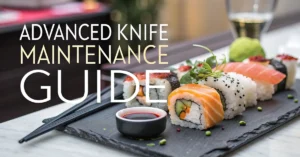Creating sushi at home is a fun and rewarding experience. But let’s face it: even the most skillfully rolled maki can look a bit sad on a plain plate. Presentation is key. More than just arranging the pieces, mastering the art of sushi plating elevates the entire dining experience. It transforms your homemade sushi from a simple meal into a feast for the eyes.
In this guide, you’ll discover how to take your sushi presentation to the next level. You’ll learn about the principles of design, the best tools and ingredients, and techniques to create stunning sushi platters that will impress your family, friends, and even yourself.
Why Sushi Plating Matters
You might think sushi is all about the taste, and it is! But consider this: studies show that visual presentation significantly impacts our perception of flavor. A beautifully plated dish simply tastes better.
Think about it. Have you ever seen a chef spend extra time arranging the food, only to mess it up? No, because that’s how food becomes even more memorable. And plating your sushi adds to the experience. Here’s how:
- Enhances the Dining Experience: Presentation makes the meal more enjoyable. Beautiful sushi platters set a positive tone and make the occasion feel special.
- Appeals to the Senses: Sushi plating isn’t just about looks. It’s about engaging all the senses. The colors, textures, and shapes create an exciting visual experience that complements the taste and aroma of the sushi.
- Shows Respect for the Food: Thoughtful plating shows you care about the ingredients and the effort that went into preparing the sushi. It’s a sign of respect for Japanese culinary traditions.
- Creates a Lasting Impression: A well-presented sushi platter is memorable. Your guests will be impressed by your attention to detail and creativity, making the meal a topic of conversation long after it’s finished.
Essential Tools for Sushi Plating
Having the right tools makes sushi plating easier and more enjoyable. Here’s a list of must-have items:
- Plates and Platters: Choose a variety of shapes, sizes, and materials. Slate, wood, ceramic, and glass all offer unique looks.
- Small Bowls: These are perfect for holding sauces like soy sauce, ponzu, or spicy mayo.
- Chopsticks: Invest in a few sets of elegant chopsticks for serving and eating.
- Garnish Tweezers: These allow for precise placement of delicate garnishes like microgreens or edible flowers.
- Squeeze Bottles: These are ideal for creating decorative sauce drizzles.
- Sushi Rolling Mat (Makisu): While primarily used for rolling sushi, a clean mat can also serve as a textural element on your platter.
- Sharp Knife: A sharp knife is essential for clean, precise cuts, which are crucial for a professional-looking presentation.
Understanding the Principles of Sushi Plating Design
Sushi plating is more than just throwing some rolls on a dish. The art of sushi plating involves applying design principles to create visually appealing arrangements. Here are some key concepts to keep in mind:
Color
Color is one of the most powerful tools in sushi plating. Use a variety of colorful ingredients to create visual interest and excitement.
- Complementary Colors: Pair colors that are opposite each other on the color wheel, such as red and green, or yellow and purple, to create a vibrant contrast.
- Analogous Colors: Use colors that are next to each other on the color wheel, such as orange, yellow, and green, to create a harmonious and balanced look.
- Monochromatic Colors: Use different shades and tints of a single color to create a sophisticated and elegant presentation.
Shape
The shape of your sushi pieces and the way you arrange them can greatly impact the overall look of your platter.
- Variety: Mix different shapes and sizes of sushi, such as maki, nigiri, and sashimi, to create visual interest.
- Arrangement: Experiment with different arrangements, such as lines, circles, and curves, to create a dynamic and balanced composition.
- Height: Add height to your platter by stacking sushi pieces or using garnishes to create vertical interest.
Texture
Texture adds another layer of complexity to your sushi plating.
- Contrast: Combine smooth, creamy textures with crunchy, crispy textures to create a more exciting and satisfying eating experience.
- Garnishes: Use garnishes like sesame seeds, tobiko, or tempura flakes to add texture and visual appeal.
Balance
Balance is essential for creating a harmonious and visually pleasing sushi platter.
- Symmetry: Create a symmetrical arrangement by mirroring elements on either side of the platter.
- Asymmetry: Create an asymmetrical arrangement by placing elements off-center, but ensure the overall composition feels balanced and visually stable.
- Negative Space: Use negative space (empty areas on the platter) to create a sense of calm and elegance. Don’t overcrowd the platter; allow each element to breathe.
Selecting the Right Plateware
The plateware you choose is the canvas for your sushi masterpiece. Consider these factors when selecting your plates and platters:
- Material:
- Slate: Provides a rustic, natural look that complements the organic nature of sushi.
- Wood: Adds warmth and texture. Bamboo is a popular choice for sushi platters.
- Ceramic: Offers a wide range of colors, shapes, and styles, from minimalist white to bold, decorative patterns.
- Glass: Creates a modern, elegant look that allows the colors of the sushi to shine through.
- Shape:
- Rectangular: Ideal for creating linear arrangements.
- Round: Works well for circular or fan-shaped arrangements.
- Square: Offers a contemporary, geometric look.
- Asymmetrical: Adds visual interest and a unique touch.
- Size: Choose a size that is appropriate for the amount of sushi you are serving. An overcrowded platter can look messy, while a sparsely populated platter can look uninviting.
Simple Sushi Plating Techniques
Here are some easy-to-execute sushi plating techniques for beginners:
The Line Arrangement
This is a simple yet effective way to showcase your sushi.
- Place a row of sushi pieces in a straight line across the plate.
- Alternate colors and textures to create visual interest.
- Add a few simple garnishes along the line, such as sesame seeds or microgreens.
The Fan Arrangement
This arrangement creates a sense of movement and elegance.
- Start by placing the largest sushi pieces at the center of the plate.
- Arrange smaller pieces in a fan shape around the center, gradually decreasing in size.
- Add a sauce drizzle or a scattering of tobiko to accentuate the fan shape.
The Scatter Arrangement
This is a more casual and contemporary approach to sushi plating.
- Scatter sushi pieces randomly across the plate.
- Vary the placement and orientation of the pieces to create a sense of spontaneity.
- Add a few small bowls of sauce and garnishes to complete the look.
Advanced Sushi Plating Techniques
Ready to take your sushi plating skills to the next level? Try these advanced techniques:
Using Height and Dimension
Creating height adds drama and visual interest to your platter.
- Use small risers or platforms to elevate certain sushi pieces.
- Stack sushi pieces on top of each other to create vertical interest.
- Use tall garnishes, such as edible flowers or sprigs of herbs, to add height and dimension.
Creating Flow and Movement
Guiding the viewer’s eye across the platter creates a dynamic and engaging presentation.
- Use lines of sauce or garnishes to create a sense of movement.
- Arrange sushi pieces in a way that leads the eye from one element to another.
- Use contrasting colors and textures to draw attention to specific areas of the platter.
Incorporating Edible Art
Adding edible art elements can elevate your sushi plating to a whole new level.
- Create sauce paintings on the plate using squeeze bottles.
- Use vegetable carvings to add intricate details and textures.
- Make edible flowers from thinly sliced vegetables or fruits.
Garnishing Like a Pro
Garnishes are the finishing touch that can elevate your sushi plating from ordinary to extraordinary. Here are some popular choices:
- Microgreens: Add a pop of color and freshness.
- Edible Flowers: Provide a delicate and elegant touch.
- Sesame Seeds: Add texture and a nutty flavor.
- Tobiko (Flying Fish Roe): Add a burst of color and a satisfying crunch.
- Shiso Leaves: Offer a unique flavor and a beautiful green hue.
- Ginger Sprouts: Provide a spicy kick and a delicate texture.
- Wasabi: Adds a pungent flavor and a vibrant green color. Use sparingly.
- Pickled Ginger (Gari): Cleanses the palate between bites and adds a refreshing flavor.
Complementary Sauces and Condiments
Sauces and condiments are essential for enhancing the flavor and presentation of your sushi. Here are some popular options:
- Soy Sauce: A classic dipping sauce for sushi. Use low-sodium soy sauce to avoid overpowering the delicate flavors of the fish.
- Ponzu Sauce: A citrus-based sauce that adds a bright and tangy flavor.
- Spicy Mayo: A creamy and spicy sauce that is perfect for adding a kick to your sushi.
- Eel Sauce (Unagi Sauce): A sweet and savory sauce that is traditionally used with grilled eel, but also pairs well with other types of sushi.
- Sriracha: A hot chili sauce that adds a fiery kick.
Choosing the Right Sushi Varieties for Plating
The type of sushi you choose can greatly impact the overall look of your platter. Here are some varieties that are particularly well-suited for plating:
- Nigiri: Hand-pressed sushi with a topping of fish or seafood. The simple, elegant shape of nigiri makes it easy to arrange and showcase.
- Maki: Rolled sushi with a variety of fillings. Maki rolls can be cut into different sizes and shapes, adding visual interest to your platter.
- Sashimi: Thinly sliced raw fish or seafood. Sashimi is prized for its delicate flavor and beautiful color, making it a great addition to any sushi platter.
- Temaki: Hand-rolled sushi cones. Temaki are fun and informal, adding a playful touch to your presentation.
- Uramaki: Inside-out rolls with rice on the outside and nori seaweed on the inside. Uramaki are often decorated with colorful toppings like sesame seeds, tobiko, or avocado.
Step-by-Step Sushi Plating Ideas
Now, let’s put everything together with some step-by-step sushi plating ideas:
Elegant Nigiri Platter
- Plate: Choose a rectangular slate plate for a natural, understated look.
- Sushi: Arrange a selection of nigiri pieces, such as salmon, tuna, and shrimp, in a row across the plate.
- Garnishes: Add small dabs of wasabi to each piece of nigiri. Sprinkle finely sliced scallions over the nigiri for a pop of color.
- Sauce: Place a small bowl of soy sauce at one end of the plate.
- Final Touch: Place a sprig of shiso leaf alongside the nigiri.
Colorful Maki Roll Display
- Plate: Choose a round ceramic plate with a subtle pattern.
- Sushi: Arrange a variety of maki rolls, such as California rolls, spicy tuna rolls, and cucumber rolls, in a circular pattern around the plate.
- Garnishes: Sprinkle black and white sesame seeds over the rolls. Add small piles of pickled ginger and wasabi to the plate.
- Sauce: Place a small bowl of spicy mayo in the center of the plate.
- Final Touch: Place a few edible flowers around the edges of the plate.
Modern Sashimi Arrangement
- Plate: Choose a square glass plate for a sleek, contemporary look.
- Sushi: Arrange thinly sliced sashimi pieces, such as salmon, tuna, and yellowtail, in a staggered pattern across the plate.
- Garnishes: Drizzle ponzu sauce over the sashimi. Add small piles of tobiko and microgreens to the plate.
- Sauce: Place a small bowl of soy sauce at one corner of the plate.
- Final Touch: Place a few thin slices of lemon and lime alongside the sashimi.
Sushi Plating for Different Occasions
The style of your sushi plating should be tailored to the occasion. Here are some ideas for different events:
- Casual Dinner Party: Focus on creating a fun and relaxed atmosphere. Use colorful plates and playful arrangements. Offer a variety of sauces and condiments for guests to customize their sushi.
- Formal Dinner Party: Aim for elegance and sophistication. Use minimalist plates and refined arrangements. Serve the sushi with traditional accompaniments, such as soy sauce, wasabi, and pickled ginger.
- Romantic Dinner: Create a sense of intimacy and romance. Use heart-shaped plates and delicate garnishes. Serve the sushi with champagne or sake.
- Holiday Celebration: Incorporate seasonal colors and elements into your sushi plating. For example, use red and green garnishes for Christmas or pastel-colored flowers for Easter.
Common Sushi Plating Mistakes to Avoid
Even with the best intentions, it’s easy to make mistakes when plating sushi. Here are some common pitfalls to avoid:
- Overcrowding the Plate: Less is more. Avoid overcrowding the plate with too much sushi or too many garnishes.
- Using Dull Knives: A dull knife will tear the sushi and create a messy presentation.
- Ignoring Color and Texture: Use a variety of colors and textures to create visual interest.
- Neglecting the Sauce: Sauce is an essential part of the sushi experience. Don’t forget to offer a variety of sauces and condiments.
- Being Afraid to Experiment: Don’t be afraid to try new things and express your creativity.
Sourcing High-Quality Ingredients
No matter how skilled you are at sushi plating, the quality of your ingredients will ultimately determine the success of your meal. Here are some tips for sourcing high-quality ingredients:
- Fresh Fish: Look for fish that is firm, shiny, and free of any fishy odor.
- Sushi Rice: Use short-grain Japanese rice specifically labeled as “sushi rice.”
- Nori Seaweed: Choose nori sheets that are dark green, crisp, and have a slightly sweet flavor.
- Wasabi: Freshly grated wasabi is the best option, but prepared wasabi paste is a convenient alternative.
- Pickled Ginger (Gari): Look for gari that is thinly sliced, crisp, and has a refreshing flavor.
The Importance of Food Safety
When preparing sushi at home, it’s essential to follow proper food safety guidelines to prevent foodborne illness.
- Keep Raw Fish Cold: Store raw fish in the refrigerator at 40°F (4°C) or below.
- Use Separate Cutting Boards: Use separate cutting boards for raw fish, vegetables, and cooked foods.
- Wash Your Hands: Wash your hands thoroughly with soap and water before and after handling raw fish.
- Use Fresh Ingredients: Use only the freshest ingredients and discard any that are past their expiration date.
- Consume Promptly: Eat sushi as soon as possible after preparation. Do not leave sushi at room temperature for more than two hours.
The History and Cultural Significance of Sushi Presentation
Sushi presentation is deeply rooted in Japanese culture and culinary traditions. The art of sushi plating dates back centuries, with each element of the presentation carefully considered to enhance the dining experience.
In traditional Japanese cuisine, presentation is just as important as taste. The way a dish is arranged is believed to reflect the chef’s respect for the ingredients and their commitment to providing a harmonious and balanced meal.
Sushi plating is also influenced by the principles of Japanese aesthetics, such as minimalism, asymmetry, and the appreciation of natural materials. These principles are reflected in the choice of plateware, garnishes, and overall arrangement of the sushi.
Mastering Sushi Plating: A Journey of Creativity and Skill
Sushi plating is a skill that takes time and practice to master. Don’t be discouraged if your first attempts aren’t perfect. The most important thing is to have fun and express your creativity.
Experiment with different techniques, ingredients, and arrangements until you find a style that you love. With patience and persistence, you’ll be creating stunning sushi platters that will impress your friends and family in no time.
Should You Master Sushi Plating?
The answer to this is a resounding yes! Mastering the art of sushi plating elevates your homemade sushi from a simple meal to a culinary experience. It enhances the flavors, engages the senses, and shows your respect for the food. By understanding the principles of design, selecting the right tools and ingredients, and practicing different plating techniques, you can create stunning sushi platters that will impress your guests and bring joy to your dining table.
So, grab your knives, gather your ingredients, and embark on a journey of creativity and skill. Your sushi adventure has only just begun.



